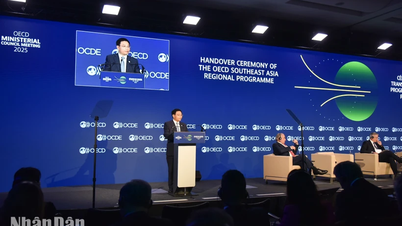In the first week of release in 1992, four volumes of Doraemon sold out 40,000 copies in Ho Chi Minh City.
From September 13 to 22, Kim Dong Publishing House and partners organized an exhibition. From Doraemon to Doraemon, 30 years of robot cat journey in Vietnam, displaying the first editions, some beautiful book covers, associated with many milestones of the manga development in Vietnam. The number of people coming to the exhibition on weekends is up to 4,000 - 5,000, the remaining days are about 250-300 people. Readers of Doraemon belong to many generations, from 8x, 9x to primary school children.
Fujiko F. Fujio's work was released in Japan in 1969, about a robot cat from the future world , helping the clumsy boy Nobita. In 1990, Mr. Nguyen Thang Vu - Director of Kim Dong Publishing House at that time - decided to translate and edit the book from the Thai version, with the collaboration of artist Bui Duc Lam. On December 11, 1992, volume one The transforming scarf issued, deemed to be the date Doraemon to Vietnam. The first books were priced at 3,000 VND, then dropped to 2,800 VND and then to 2,500 VND. Rarely does a book decrease in price as it is published, due to the increasing number of copies printed, and the cost is adjusted.

In the article published in the newspaper Women of Ho Chi Minh City December 1992 issue, later reprinted by the publisher at the end of volume six - Sharks come ashore - of the Doraemon series, author Luu Hong Cuc reviews the series' records when it was first published in the country. According to her, after a week of release, the first four volumes sold out 40,000 copies in Ho Chi Minh City. The publisher quickly printed an additional 30,000 copies but still could not meet the demand. In the end, they decided to release 160,000 copies of the four volumes.
"On December 22, 1992, due to printing problems (power outage), the book was released later than announced. A bustling scene took place in the yard of Kim Dong Publishing House: Book distributors stood crowded, waiting. Doraemon Every hour, the question "When will there be books?" is constantly being asked. The book rental community around primary schools does not miss this rare opportunity: Renting books. Doraemon on the spot - for 200 VND per volume. So it's a win-win situation: In one day, the renter earns from 4,000 VND to 8,000 VND, and the young readers only have to skip two meals," wrote Luu Hong Cuc.

The characters' names were Vietnamized as Doraemon, Chaien Loi Ron, Xeko Be Nhon, Dekhi. From volume 16, the publisher opened a small column called "Doraemon's Office". Readers at that time often sent letters of confidences and contest entries to the office.
In 1996, author Fujiko F. Fujio came to Vietnam to sign the copyright procedures for the series. He and publisher Shogakukan contributed one billion VND (royalty fee for the series in the first four years in Vietnam) to the Doraemon scholarship fund. Kim Dong publisher also contributed another billion VND from the profits of the series. To this day, the fund is still operating, giving many gifts to poor students who overcome difficulties every year.
In 1998, Doraemon was reprinted for the first time with the cover art according to the original Japanese version, keeping the character names from the 1992 print. By 2006, there were about 40 to 50 million copies of Doraemon released in Vietnam.
In 2010, Kim Dong Publishing House stopped publishing books with the name Doraemon, replace with Doraemon, with a translation that closely follows the Japanese. Other characters were also changed to their original names of Shizuka, Jaian, Suneo, Dekisugi. The format of the book also changed, with printing from right to left, similar to the way manga is read in Japan. After this period, in addition to the traditional comic book version, Doraemon Reach readers through channels such as movies, animated series, and color comics.
Explaining the appeal of Doraemon, "According to Fujiko F. Fujio, his stories often have science fiction elements, but they are not necessarily rigid or complicated science fiction. Instead, they bring about magic, excitement, and a bit of mystery, creating a special appeal," said curator and independent manga researcher ChuKim.
Source






































































































Comment (0)